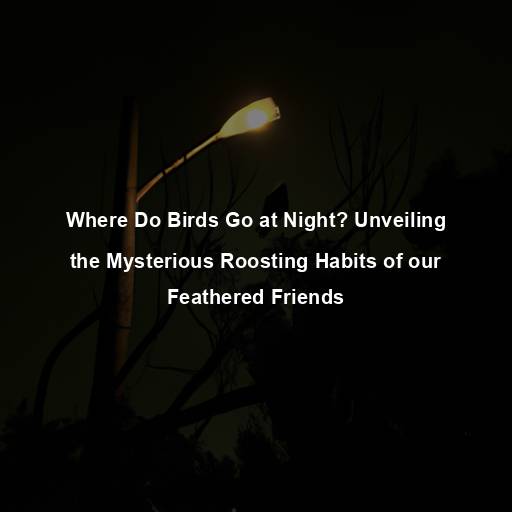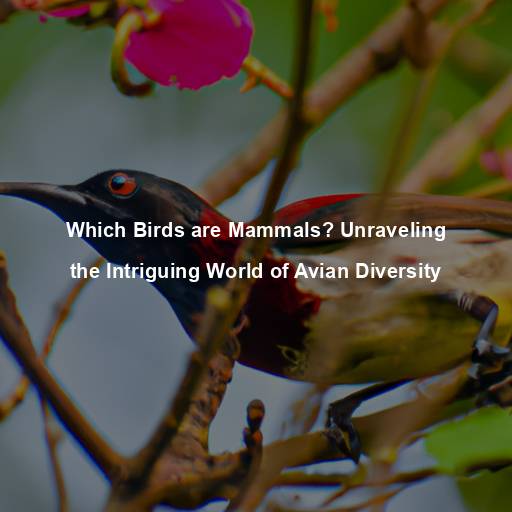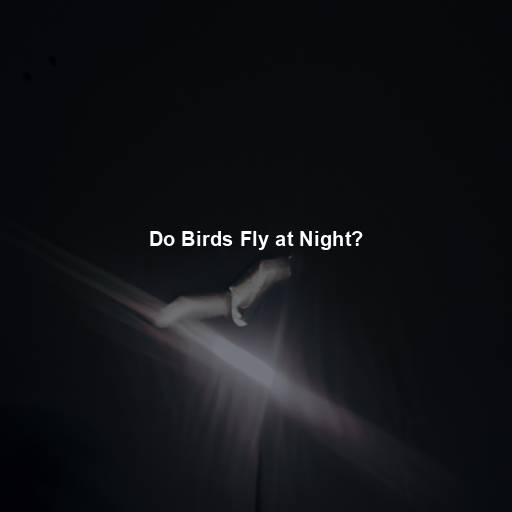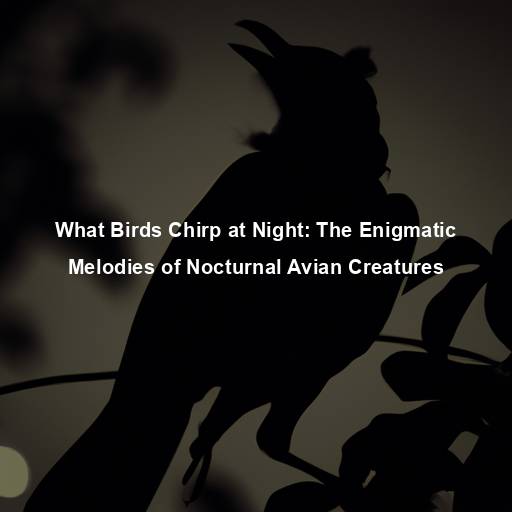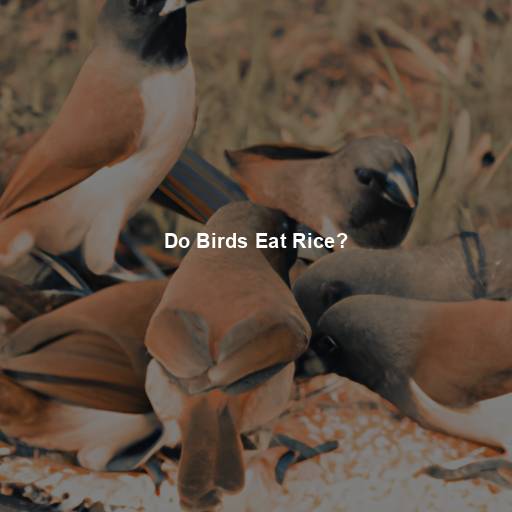Where Do Birds Go at Night? Unveiling the Mysterious Roosting Habits of our Feathered Friends
Last Updated on October 22, 2023 by Evan
Contents
- 1 The Fascinating World of Birds
- 2 The Need for Rest: Bird Sleep Patterns
- 3 The Magic of Bird Migration
- 4 The Beauty of the Night, Unveiled
- 5 The Nocturnal World Revealed
- 6 A Symphony of Nature
- 7 FAQs for the topic: Where are birds at night
- 7.1 ### Do birds sleep at night?
- 7.2 ### Where do birds sleep at night?
- 7.3 ### Do birds migrate at night?
- 7.4 ### Why do birds sing at night?
- 7.5 ### Are all birds active during the night?
- 7.6 ### How do birds protect themselves at night?
- 7.7 ### Can birds see in the dark?
- 7.8 ### Do all birds sleep at the same time?
- 7.9 ### How do urban environments affect bird sleeping patterns?
- 7.10 ### Can birdwatchers observe birds at night?
The Fascinating World of Birds
Birds, those magnificent creatures that grace our skies with their vibrant feathers and enchanting songs, have long captivated the human imagination. From the agile flight of the hummingbird to the majestic soar of the eagle, birds have adapted to a myriad of environments, making them one of the most diverse groups of animals on Earth. Yet, as the sun sets and darkness blankets the landscape, one question often arises: Where do birds go at night? In this captivating exploration, we will delve into the mysterious roosting habits of our avian friends, shedding light on their hidden nocturnal world.
The Need for Rest: Bird Sleep Patterns
Just like humans, birds require rest to rejuvenate their bodies and minds. However, their sleep patterns differ significantly from our own. While we humans enjoy a consolidated period of sleep, birds adopt a unique approach known as “unihemispheric slow-wave sleep”. This means that they can sleep with one hemisphere of their brain at a time, allowing them to remain alert to potential dangers while still obtaining necessary rest.
1. Birds exhibit unique sleep patterns, including “unihemispheric slow-wave sleep” where they sleep with one hemisphere of their brain at a time.
2. Birds choose various roosting spots at night, such as trees, caves and crevices, and roosting colonies, for safety and shelter.
3. Birds have adaptations to survive the night, such as puffing up their feathers for insulation and tucking their heads beneath their wings for warmth.
4. Birds have found ways to adapt to urban environments, roosting on skyscrapers, bridges, and streetlights.
5. Bird migration is a fascinating phenomenon, driven by seasonal changes and providing access to resources and breeding grounds.
6. Roosting plays a vital role in energy conservation, predator protection, weather protection, and social bonding for birds.
7. Birds have remarkable adaptations for night vision, vocalize in the dark, forage at night, and navigate during nocturnal migration.
8. The world of birds at night offers a mysterious and captivating symphony of nature’s strategies and survival instincts.
Roosting: Seeking Safe Haven
As the sun fades and the night cloaks the world in its mysterious embrace, the feathered inhabitants of the sky embark on a quest for sanctuary. Roosting, a ritual of solace and respite, consumes their desires. An array of enigmatic variables guides them towards their chosen abodes – safety from lurking predators, a shield from nature’s wrath, and the whispers of a nearby feast. Join us as we venture into the realm of typical roosting abodes, where avian secrets unveil.
a. Trees: Nature’s Cozy Abodes
Trees, with their sturdy branches and leafy canopies, provide birds with ideal roosting spots. The dense foliage offers protection from predators, while the branches offer secure perches for a good night’s sleep. Different bird species exhibit distinct preferences for tree roosts. Owls, for instance, often choose hollow tree trunks, while songbirds opt for dense shrubs or thickets.
b. Caves and Crevices: Stealthy Hideouts
For some avian creatures like swifts and swallows, the allure of secretive habitats is undeniable. Their affinity for seeking shelter in mysterious caves, hidden crevices, and rugged cliffs is not only a matter of preference; it’s a deeply ingrained survival instinct. Within these enigmatic corners of nature, they find solace from the prying eyes of predators and the unpredictable wrath of Mother Nature. It’s as if these dark retreats hold the secrets to a peaceful slumber, keeping these graceful birds safe from harm’s way.
c. Roosting Colonies: Safety in Numbers
In the vast tapestry of nature’s intriguing wonders, one phenomenon that never fails to bewilder and captivate the minds of both seasoned ornithologists and curious onlookers alike is the majestic sight of birds assembling in immense flocks, known as roosting colonies. Within these mesmerizing gatherings, numbering in the thousands or even millions, these feathered creatures embark on a breathtaking display of unity and interconnectedness. As if orchestrated by an unseen conductor, this avian ballet unfolds before our astonished eyes, as each individual finds solace and safety within the harmonious symphony of the collective. Delving into the tapestry of nature’s grand design, one can’t help but marvel at the strategic advantages offered to these social species – the life-saving shield against would-be predators, the comforting warmth shared on chilly nights, and the profound sense of community reverberating through the air.
Avian Adaptations: Surviving the Night
When the sun dips beneath the horizon, a marvel of nature unfolds. Birds, with their incredible prowess, have charted an extraordinary course to conquer the enigmatic night. They possess a magnificent array of adaptations that defy conventional understanding – from energy-saving techniques to the ability to keep warm during slumber. Embracing the nocturnal realm with unwavering vigilance, they navigate the darkness with an elegance that leaves us in awe.
a. Puffing Up: Nature’s Feathered Insulation
When temperatures drop, birds have a clever trick up their wings. They puff up their feathers, creating an insulating layer of warm air between their bodies and the chilly outside air. This natural insulation helps them retain body heat, ensuring they stay cozy throughout the night.
b. Tucking in: Hunkering Down for the Night
As twilight descends upon the natural world, an enigmatic ritual unfolds, showcasing the mysterious elegance of our avian friends. In a display of instinctual brilliance, birds engage in a captivating act known as “tucking in” before they succumb to the gentle embrace of sleep. With an enchanting grace, they delicately tuck their heads beneath their wings and draw their legs close to their bodies, as if navigating an intricate dance of thermoregulation. In this enigmatic posture, they embark on a nocturnal sojourn, preserving precious energy and ensconcing themselves in a cocoon of warmth amidst the chill of the night.
c. Alarm Calls: Staying Vigilant
As the sun sets and darkness takes over, a mysterious phenomenon unfolds in the avian world. Even in their slumber, birds maintain a constant state of vigilance, always ready to spring into action. They communicate through a complex web of alarm calls, a secret language that signals danger and keeps their comrades safe from harm. With an uncanny ability to detect even the faintest sounds, these feathered sentinels can swiftly mobilize their entire roosting community, ensuring the collective security of their sanctuary.
Urban Roosts: Birds in the City
It’s fascinating to observe how birds have conquered the bustling cityscape, defying all expectations. These feathered urban pioneers have ingeniously sought refuge in the unlikeliest of places, turning towering buildings, bridges, and even streetlights into their urban nesting grounds. Their adaptability and resourcefulness never cease to amaze, defying the limits of their natural habitats and adding a touch of enchantment to our concrete jungle.
a. Skyscrapers: Rooftop Retreats
The height and structure of skyscrapers mimic the natural roosting spots birds would find in cliffs or trees. Many bird species have taken advantage of this vertical habitat, seeking refuge on rooftops and ledges. Pigeons, for example, are well-known urban roosters, often congregating on high-rise buildings.
b. Bridges: Suspended Sanctuaries
Bridges, with their sturdy beams and hidden nooks, provide birds with secure roosting sites. The spaces between the beams offer protection from the elements while remaining relatively concealed from predators. It is not uncommon to witness flocks of swallows or swifts gracefully perched under the arches of a bridge, finding solace amidst the urban landscape.
c. Streetlights: Illuminated Rest Stops
When the moon takes its nightly retreat and darkness descends upon the concrete jungle, a peculiar sight unfolds. Birds, the enchanting creatures of the skies, seek solace in an unexpected haven – streetlights. Yes, you read it right! These flying marvels find comfort in the warm embrace of the luminous fixtures that punctuate the urban landscape.
The Magic of Bird Migration
While understanding where birds roost at night unveils part of their nocturnal world, we cannot ignore the captivating phenomenon of bird migration. Many bird species undertake incredible journeys, traveling thousands of miles to find suitable breeding grounds or escape harsh weather conditions. Migration provides birds with access to abundant resources and helps maintain healthy populations across different ecosystems.
Seasonal Migration: Following Nature’s Call
Bird migration occurs in response to seasonal changes, primarily driven by fluctuations in food availability and breeding requirements. As winter approaches, many bird species embark on long-distance journeys to warmer regions, where resources are more abundant. In contrast, as spring arrives, they navigate back to their breeding grounds, ready to raise the next generation.
The awe-inspiring world of avian navigation never ceases to amaze, as birds gracefully chart their course through the heavens. It’s a mesmerizing dance of celestial landmarks, the Earth’s magnetic embrace, and even the scent of the winds. As scientists tirelessly probe the depths of this enigmatic phenomenon, the mysteries behind these feathered travelers’ uncanny ability to plot their journeys remain tantalizingly unresolved.
Rest Stops: Pit Stops for Weary Travelers
During their migratory journeys, birds need to rest and refuel along the way. This leads them to seek out suitable roosting sites, often in diverse habitats such as wetlands, forests, or coastal areas. These rest stops provide crucial opportunities for birds to replenish their energy reserves before continuing their arduous journeys.
The Beauty of the Night, Unveiled
As the night sky unfolds, the world of birds comes alive in ways we may never fully witness or comprehend. Their nocturnal adventures remain shrouded in mystery, captivating our imagination and inspiring us to appreciate the beauty and resilience of these winged wonders. So, the next time you gaze at the stars, remember the birds that silently roost nearby, cherishing the secrets of the night. ## The Importance of Roosting: Ensuring Survival
Roosting, an intriguing aspect of avian life, goes beyond mere rest for our winged companions. It plays a pivotal role in their very existence, offering a myriad of benefits vital to their survival. From efficiently conserving precious energy to evading cunning predators, the act of roosting encompasses essential facets that nurture their overall welfare. Today, we delve into the captivating world of roosting, unraveling its profound significance in the lives of our beloved feathered creatures.
The Energy Equation: Conserving Vital Resources
In the intriguing world of birds, energy conservation is a crucial survival skill. Bursting with vitality, these fascinating creatures navigate the enigmatic labyrinth of nature’s challenges. When chilly winds whisper and nourishment hides behind frozen landscapes, birds adopt a cunning strategy called roosting. This perplexing behavior allows them to gracefully lower their metabolic rate and shield themselves from the dual specters of frigid temperatures and scarce sustenance.
Predator Protection: The Safety of Numbers
Roosting in groups provides birds with an added layer of protection against predators. By gathering in large numbers, birds increase their chances of detecting and deterring potential threats. When predators approach a roosting colony, the birds collectively sound alarm calls, alerting others and increasing the chances of survival for the entire group. This collaborative defense mechanism is a testament to the strength of social behavior in the avian world.
Microclimates: Weathering the Storm
Roosting sites offer birds a microclimate that helps them withstand harsh weather conditions. Whether it’s seeking refuge from strong winds, heavy rain, or extreme temperatures, birds select roosting spots that provide them with the necessary shelter. Natural formations like trees, caves, or cliffs create a buffer against the elements, allowing birds to conserve body heat and stay dry during inclement weather.
Social Bonding: Strengthening Relationships
When birds come together to form roosting colonies, they not only find safety in numbers, but also engage in a captivating dance of social interactions. These communal gatherings provide a unique platform for avian companions to forge bonds, exchange stories through various vocalizations, and establish their pecking order within the species. It is in these vibrant gatherings that birds strengthen their social connections, creating a web of relationships that prove invaluable during breeding seasons and epic migratory adventures that lie ahead.
The Nocturnal World Revealed
From the crack of dawn to the twilight, our feathered friends grace us with their lively presence, painting the sky with their vibrant plumage and melodious tunes. However, as the sun sets and darkness takes hold, a veil of mystery descends upon these winged creatures, stirring a sense of perplexity and awe within us. Delving into the depths of their nocturnal escapades, we uncover a parallel universe where they navigate with stunning precision and adaptability, offering us a glimpse into their enigmatic hidden lives.
Adaptations for Night Vision
Birds have developed remarkable adaptations to navigate and function in low-light conditions. Their eyes are highly specialized, equipped with a higher density of light-sensitive cells called rods. This allows them to perceive details even in dim light. Additionally, the arrangement of their photoreceptors enhances their ability to detect motion, making them adept at spotting prey or potential threats during the night.
Vocalizations in the Dark
There is a secret language that fills the night, a symphony of sound that only those who dare to listen can truly appreciate. Birds, those feathered creatures of wonder, have unlocked this mystical realm with their enchanting vocalizations. It is in the cover of darkness that their songs transform into something truly extraordinary, captivating our imagination and igniting our curiosity. From the haunting hoots of owls to the intriguing calls of nightjars, these nocturnal melodies serve as a multifaceted expression of territories, romance, and cautionary tales, weaving a tapestry of sounds that perplexes and inspires.
Nighttime Foraging: A Stealthy Pursuit
Birds of the night, those exquisite nocturnal foragers, possess a mysterious allure that beckons us into their fascinating world. The enigmatic night herons and nighthawks, with their astonishing adaptations, demonstrate the art of survival under the cloak of darkness. Through their exceptional hearing capabilities and uniquely crafted beaks, they navigate the nocturnal abyss, fearlessly seizing their prey with precision and finesse. These captivating creatures unravel nature’s secret code of survival, inspiring us to explore the depths of their extraordinary existence.
In the realm of avian migration, a captivating phenomenon resides in the cloak of nightfall. As daylight fades, certain bird species bravely embark on their epic journeys, obscured by the enigmatic darkness. Drawing on a cryptic repertoire of cosmic signposts, celestial constellations, and the ever-pulsating magnetism of our planet, these intrepid travelers chart their path with mystifying precision. A harmonious symphony of adaptation unfolds as they elude the watchful eyes of predators and skillfully harness the whimsical winds, defying the odds to secure their safe arrival at their coveted haven.
A Symphony of Nature
As the sun sets and darkness creeps in, the avian realm embarks on an enigmatic journey. A mystical transition unfolds, casting the night sky as an enchanting theater where feathered marvels command our attention. Reflecting their astonishing adaptability, these winged beings unveil a symphony of strategies, from seeking secure havens to navigating the nocturnal abyss, revealing a perplexing tapestry of survival instincts and indomitable spirit. Through their resolute perseverance and astonishing ingenuity, birds bewitch us with their mesmerizing prowess in the face of constant change.
As the night falls and the sky embraces its nocturnal shroud, a captivating world of avian secrets comes alive. The enigmatic roosting habits and adaptations of these remarkable creatures leave us in awe and bewilderment. Though we may never unravel the intricacies of their nocturnal lives entirely, let us revel in the mystery and ponder the symphony of nature that unfolds when the twilight hour greets the perched birds.
FAQs for the topic: Where are birds at night
### Do birds sleep at night?
Yes, birds do sleep at night, but their sleeping patterns vary depending on the species. Most birds are diurnal, which means they are active during the day and sleep at night. They usually find a safe and secluded spot in trees or shrubs to rest and conserve energy for the next day.
### Where do birds sleep at night?
When it comes to the snooze game, birds are a fascinating bunch. It’s mind-boggling to see the variety of sleep preferences they have. While some birds cozy up in their meticulously crafted nests, others opt for the perch life, catching their Z’s on branches or hidden away in tree hollows. And let’s not forget those night owls – quite literally – who take the nightshift, spreading their wings for nocturnal hunts and shuteye. Truly, the avian world is bursting with perplexing sleep choices and habitats.
### Do birds migrate at night?
Yes, many bird species migrate at night. Migration is a long and energy-demanding journey, so birds often choose to fly during the night to avoid predators and take advantage of cooler temperatures. They use celestial cues, such as stars and the moon, to navigate and find their way to their wintering or breeding grounds.
### Why do birds sing at night?
The avian world occasionally breaks free from the constraints of diurnal rhythms, with some species serenading the darkness with their melodic tunes. Understanding the motivations behind these nocturnal vocalizations is a perplexing endeavor. While the age-old quest for mates and the urge to safeguard their territories remain as steadfast motivations, a myriad of enigmatic factors come into play. It is not uncommon for the luminosity of artificial lighting or the copious availability of nocturnal nourishment to sway these feathered crooners to serenade even under the moonlit sky.
### Are all birds active during the night?
Contrary to popular belief, not all our feathered friends are creatures of the night. In fact, the majority of bird species prefer to soak up the sun and strut their stuff during the daylight hours, capitalizing on their keen sense of sight to hunt and explore. Yet, in the mystical realm of the avian world, there exists a bewitching cast of characters that defy convention. Enter the enchanting owls and their nocturnal counterparts, embracing the darkness with nocturnal activities that range from stealthy hunting escapades to captivating symphonies under a moonlit sky. It’s a puzzling and mesmerizing world of contrasts, where some birds embrace the night while others bask in the glory of the day.
### How do birds protect themselves at night?
Birds employ various strategies to protect themselves at night. Some species choose roosting locations that offer good concealment from predators, such as dense foliage or tree cavities. Owls, on the other hand, have excellent night vision and hearing, which helps them detect and evade threats. Additionally, flocking together in large numbers during the night can provide safety in numbers for many bird species.
### Can birds see in the dark?
In the mysterious realm of the avian kingdom, an intriguing phenomenon takes flight – the enigmatic contrast between the night vision prowess of our feathered friends and our human limitations in the dark. While it is true that birds hold an advantage in the nocturnal realm, the intricacies of this ability vary amongst their diverse species. Enter the majestic nocturnal birds, such as the wise and watchful owls, adorned with grandiose eyes adorned with an abundance of rods – the microscopic heroes responsible for collecting precious rays of light. These remarkable adaptations gift them with the power to navigate the dusky depths with unmatched vision, a gift envied by us mere humans. Yet, it is important to note that not all winged wonders possess the gift of the night. Diurnal birds, those who bask in the brilliance of daylight, instead rely on their unparalleled color vision and visual acuity to conquer the sun-soaked skies, rather than venturing into the abyss of complete darkness. The mesmerizing secrets of bird vision continue to captivate us, reminding us of the perpetual mysteries hidden within the natural world.
### Do all birds sleep at the same time?
Birds have fascinating and diverse sleeping habits that may leave you wondering. It’s a common misconception that all birds hit the sack at the same time. Nope, not even close! These feathered creatures have their own unique sleep schedules, which can often be influenced by factors like climate, migration, and predator avoidance. For instance, under the night sky, some birds like sparrows prefer to cozy up and roost shortly after sunset, while others, like nightjars, prefer to stay up and engage in nocturnal foraging. These behavioral adaptations make bird sleep patterns a perplexing and bursty topic to explore!
### How do urban environments affect bird sleeping patterns?
Urban environments can impact bird sleeping patterns in various ways. Artificial lighting in cities can confuse nocturnal birds, disrupt their natural circadian rhythm, and affect their ability to find suitable resting spots. While some species may adapt and find urban roosting areas, others may experience reduced sleep quality, leading to potential negative effects on their overall health and survival. Providing dark, undisturbed areas and minimizing unnecessary lighting can help mitigate these effects and create a more bird-friendly urban environment.
### Can birdwatchers observe birds at night?
Exploring the mysterious world of nocturnal avian creatures can sometimes feel like navigating through an enigma wrapped in darkness. Unveiling the secrets of birds that embrace the twilight hours demands a sharp eye, cunning equipment like binoculars or cutting-edge night vision scopes, and perhaps even the guidance of seasoned experts leading you through the nocturnal wilderness. Nevertheless, utmost respect for these elusive beings is paramount, as we venture into their realms. Adhering fervently to regulations and guidelines set to safeguard their lifeblood is the key to ensuring their prosperous existence amidst the perplexing wonders of the night sky.

